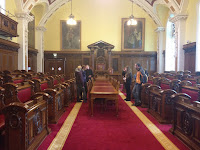The day was decent, just overcast as usual. All of the ISA students meet with Paul after classes to walk down to City Center to take a tour of Belfast City Hall. Kelsey, one of the students, befriended a city council member, Colin Keenan (Colin's Council Profile), in one of their shared classes. Colin set us up on a tour of City Hall. The tour guide was very informative, giving us all of the history of the different parts of the immense building and the city that it was built for. I'll try to give some of the great information he shared along with these pictures.
Before
getting into the actual tour and pictures, I'll give a summary of Belfast
itself. For many centuries, Belfast was a small
settlement. Everything changed in 1613, when a Royal charter gave
Belfast town status. It expanded rapidly, becoming an important port and
manufacturing center. By the end of the 19th century, Belfast had
outgrown its status as a town and was a major industrial powerhouse, known for
its shipbuilding, ropemaking, engineering, tobacco, and textile
industries. In 1888, Queen Victoria gave Belfast the title of city and it
was generally agreed that a new city hall was needed to reflect this change in
status.
The coat of
arms of Belfast, which can be seen in several of the following photographs, originated in 30
June 1890 when the Ulster King of Arms made a Grant of Arms to the new
city of Belfast. The meaning of many of the symbols within the coat of arms is
unknown these days. However, images such as the bell, the seahorse, the
ship and the chained wolf were all used by 17th century Belfast merchants on
their signs and coinage. The seahorse, which is used twice, shows the maritime
importance of Belfast, as does the ship at the base of the shield.
 Now on to the tour. Upon first entering City Hall and looking up, you see into the huge main dome of City Hall. The metal chandelier, that you can just see in the picture, is about the size of a small car. Under this, we started off on our tour. On the ground floor, we were shown several artifacts, and given information about some of the city's history. Quickly, however, the tour moved to and up the great staircase, seen here with the coat of arms of Belfast. The tour guide told us all about this and more a lot of the basic information about the building of City Hall.
Now on to the tour. Upon first entering City Hall and looking up, you see into the huge main dome of City Hall. The metal chandelier, that you can just see in the picture, is about the size of a small car. Under this, we started off on our tour. On the ground floor, we were shown several artifacts, and given information about some of the city's history. Quickly, however, the tour moved to and up the great staircase, seen here with the coat of arms of Belfast. The tour guide told us all about this and more a lot of the basic information about the building of City Hall.

After seeing the Council Chamber, and several other pretty fantastic rooms, we came to the Great Hall. During World War II, this room was completely obliterated by a German air strike on 4-5th May 1941. After the war was over, the room was completely redone to the exact look as it was before. Luckily, the city was smart enough to remove the stained glass windows before the war affected the city. So here is the Great Hall in all of it's glory (at least as much as my phone can show)!
After the tour, Colin was nice enough to take us to his party's chambers for tea. We talked about everything from school to politics to just everyday life. We all really enjoyed our time here, and went home with a lot of great new information about this city that we have become a part of and will continue to embrace during our semester here. Upon leaving City Hall after our great visit, Colin gave us a going away gift! We each got a City Council pen and a book all about the City Hall. This book has a lot of useful and interesting information; it even helped me write this post. If you want to know anything else, just ask and I can look it up!







Great Article it its really informative and innovative keep us posted with new updates. its was really valuable. thanks a lot.
ReplyDeleteVintage Chandeliers